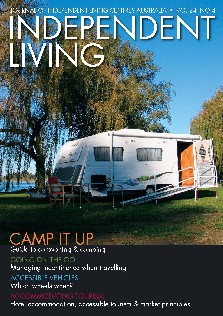
Publications
Independent LivingVolume 24 No 4
published in December 2008
Featured Articles
Going on The Go (continence management in travels)
Incontinence is a significant health issue affecting 3.8 million Australians. A person experiencing incontinence may hesitate to plan a holiday or outing in fear of embarrassment of having an accident. Providing people with the information they need to confidently manage incontinence when travelling can help with their enjoyment of the trip.Continence management is unique for each person and it is important that they consult with their own local continence health professional (eg doctor, continence nurse advisor or local community health service) for assistance and advice prior to travelling.
Camping Out (guide to caravanning & camping)
Many people enjoy the recreation of caravanning whether it is for a weekend, or an extended trip around the country. For people with a disability who like camping out, there is a range of equipment available to assist in making the experience carefree and enjoyable.The article consists of a 4-page liftout guide containing key points summary and charts for easy reference. Key points of consideration include:
- Site pre-booking
- Caravan layout
- Getting in and out of the caravans
- Showering / Toileting on-site
- Managing heat and fatigue
- Walking
Accessible Vehicles (which wheels when)
Access to the community is vital to help maintain quality of life for people who are wheelchair users. It is something that the rest of the community take for granted however for a person who is a wheelchair user careful planning is required for a successful outcome.Modifying a vehicle to allow the person and the wheelchair to be transported together can eliminate the task of physically transferring in and out of a vehicle. An otherwise perfect wheelchair will be of little value if the person and the wheelchair cannot be transported in a vehicle.
Accessing a vehicle in a wheelchair requires either the purchase of a suitably modified vehicle with a ramp or platform lift entry, or a second-hand vehicle that is suitable for modification.
Accommodating Tourism (accom, accessible tourism)
Article covers hotel accommodation, accessible tourism and market principles.The Commonwealth Government’s (2003) White Paper identified people with disabilities and seniors as emergent groups who seek tourism experiences. These niche groups were identified as the accessible tourism market. The needs of this market are multi-dimensional where access encompasses mobility, vision, hearing and cognitive dimensions. Through developing marketing responses to incorporate these dimensions, the accommodation sector will be well positioned with a competitive advantage to meet global tourism trends. This paper provides an overview of the accessible tourism market, a review of accommodation information provision, and presents the findings into consumer preferences to accessible accommodation information provision.
Globally there are over 600 million people with disabilities (Fujiura & Rutkowskikmitta, 2001; Mercer & MacDonald, 2007), equating to about 10% of humanity. Approximately 20% of the Australian population, or four million people, identify as having a disability. Of these people 520,000 have a mobility disability, 480,000 are blind or vision impaired, and one million are deaf or hearing impaired (Australian Bureau of Statistics, 2003). The numbers of people with disabilities are set to increase due to the ageing of the population. The WHO (2007) states that, by 2020, there will be 1.2bn people over 60. The ‘greying’ of the population has been well documented by the ABS, identified by Tourism Research Australia as an opportunity (2005) and affects all of our major inbound markets. These trends have considerable implications for global tourism (Dwyer, 2005).
